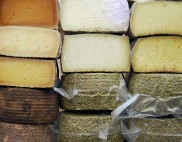
The Tradition of Queso Manchego
If you go to the La Mancha region in central Spain, home to the famous Don Quixote, you’ll have the pleasure of tasting queso Manchego, or Manchego cheese. Of course, you can sample this cheese in other parts of the country, and even abroad, but there is nothing like nibbling on the real thing in the land of its origin.
This cheese, which is made from sheep’s milk, and aged no less than 60 days, has got a lot of history behind it. Archeological digs have turned up evidence suggesting that this very unique cheese was being made well before the time of Christ. One of the main purposes of making cheese in the past was to persevere the milk and the health benefits derived from dairy, since refrigeration wasn’t available at the time.
These days, only very special ewes (female sheep) are use in the Manchego cheese making process. The queso is actually protected by the Spanish Government with a ‘Denominación de Origen,’ which means only certain cheeses can be labeled as Manchego cheese. For this tasty and buttery cheese to be called ‘Manchego,’ it has to come from La Mancha. Only the fatty milk from authentic Manchega ewes, which are descended from sheep that have been roaming these lands for centuries, can be used to create the cheese. And the cheese itself must be aged in local caves.
The technical cheese making process consists of milking the ewes by hand, and then putting the milk in curdling vats, where natural curdling enzymes are added to the mix. Then the cheese curd is sliced up into tiny bits and aged. If you ask any of the locals what is the most important aspect in making Manchego cheese, you’re sure to get different answers, but aging the cheese, and the special nature of Manchega ewes will be sure to top the list.
If all of the above requirements are met, you still have a choice between classic Manchego cheese that comes from unpasteurized milk, and the kind that comes from pasteurized milk. In addition to these basic distinctions, you can also select quesos of different ages. Manchego cheese is well known for its creamy texture, but the flavor varies between the semi-cured Manchego Curado and the richer Manchego Viejo. There is even a fresh cheese, Manchego Fresco, you can buy and sample before it has completed the aging process. The best thing for you to do is to head to La Mancha and try all of these wonderful cheeses for yourself.
 Follow
Follow


